Quantitative Reasoning & Analysis: Explanation of Statistical Output
VerifiedAdded on 2023/06/04
|6
|1390
|141
Homework Assignment
AI Summary
This assignment provides a detailed explanation of key statistical concepts related to quantitative reasoning and analysis. It begins by defining Pearson linear correlation and its role in measuring the strength of a linear association between two continuous random variables. The assignment then proceeds to explain the meaning of several output items, including the t-statistic, degrees of freedom, p-value, alternative hypothesis, and the 95% confidence interval. Each concept is clearly defined and explained with examples. The assignment also addresses the rejection of the null hypothesis based on the p-value and statistical significance. Finally, the assignment includes a list of relevant references to support the information provided.
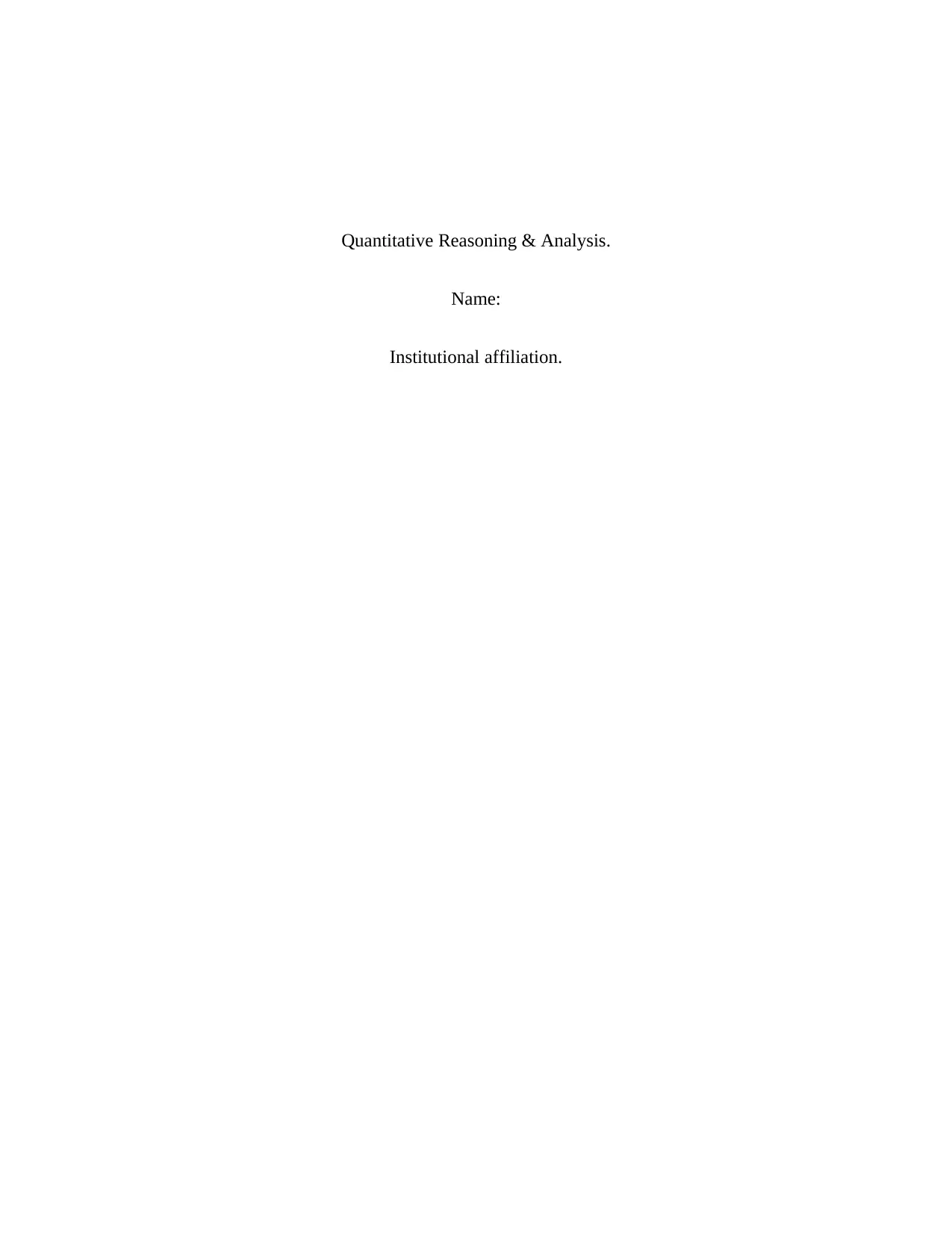
Quantitative Reasoning & Analysis.
Name:
Institutional affiliation.
Name:
Institutional affiliation.
Paraphrase This Document
Need a fresh take? Get an instant paraphrase of this document with our AI Paraphraser
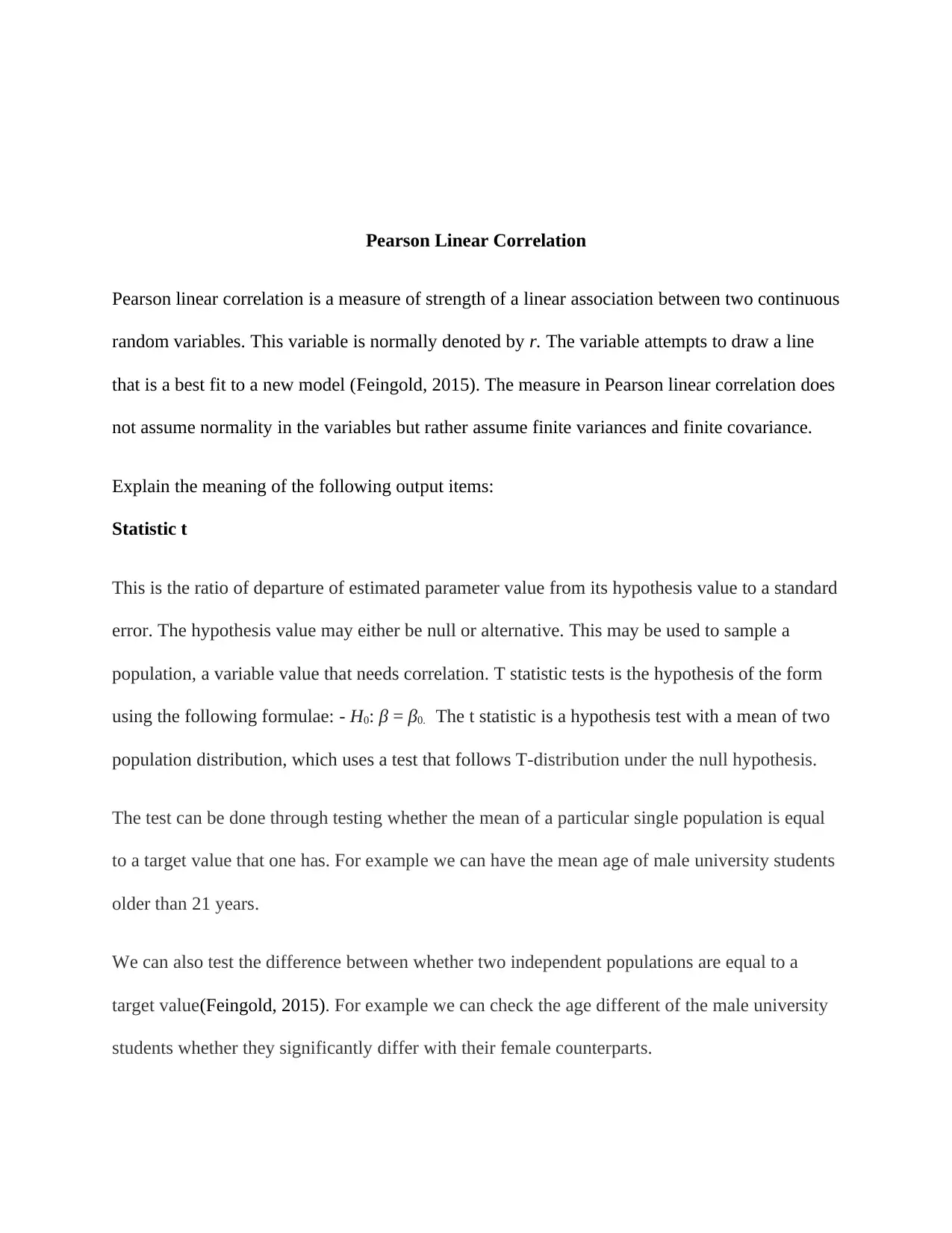
Pearson Linear Correlation
Pearson linear correlation is a measure of strength of a linear association between two continuous
random variables. This variable is normally denoted by r. The variable attempts to draw a line
that is a best fit to a new model (Feingold, 2015). The measure in Pearson linear correlation does
not assume normality in the variables but rather assume finite variances and finite covariance.
Explain the meaning of the following output items:
Statistic t
This is the ratio of departure of estimated parameter value from its hypothesis value to a standard
error. The hypothesis value may either be null or alternative. This may be used to sample a
population, a variable value that needs correlation. T statistic tests is the hypothesis of the form
using the following formulae: - H0: β = β0. The t statistic is a hypothesis test with a mean of two
population distribution, which uses a test that follows T-distribution under the null hypothesis.
The test can be done through testing whether the mean of a particular single population is equal
to a target value that one has. For example we can have the mean age of male university students
older than 21 years.
We can also test the difference between whether two independent populations are equal to a
target value(Feingold, 2015). For example we can check the age different of the male university
students whether they significantly differ with their female counterparts.
Pearson linear correlation is a measure of strength of a linear association between two continuous
random variables. This variable is normally denoted by r. The variable attempts to draw a line
that is a best fit to a new model (Feingold, 2015). The measure in Pearson linear correlation does
not assume normality in the variables but rather assume finite variances and finite covariance.
Explain the meaning of the following output items:
Statistic t
This is the ratio of departure of estimated parameter value from its hypothesis value to a standard
error. The hypothesis value may either be null or alternative. This may be used to sample a
population, a variable value that needs correlation. T statistic tests is the hypothesis of the form
using the following formulae: - H0: β = β0. The t statistic is a hypothesis test with a mean of two
population distribution, which uses a test that follows T-distribution under the null hypothesis.
The test can be done through testing whether the mean of a particular single population is equal
to a target value that one has. For example we can have the mean age of male university students
older than 21 years.
We can also test the difference between whether two independent populations are equal to a
target value(Feingold, 2015). For example we can check the age different of the male university
students whether they significantly differ with their female counterparts.
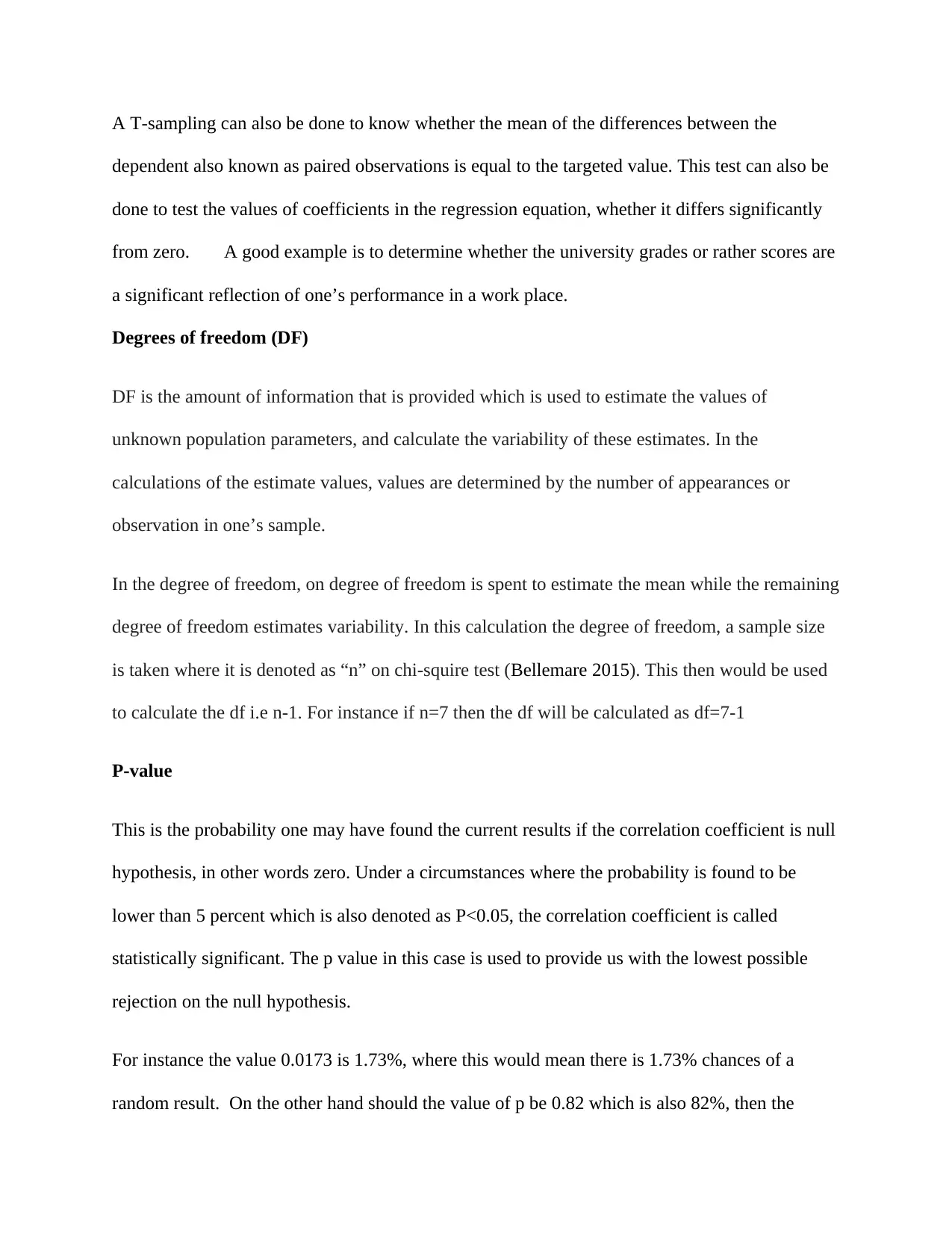
A T-sampling can also be done to know whether the mean of the differences between the
dependent also known as paired observations is equal to the targeted value. This test can also be
done to test the values of coefficients in the regression equation, whether it differs significantly
from zero. A good example is to determine whether the university grades or rather scores are
a significant reflection of one’s performance in a work place.
Degrees of freedom (DF)
DF is the amount of information that is provided which is used to estimate the values of
unknown population parameters, and calculate the variability of these estimates. In the
calculations of the estimate values, values are determined by the number of appearances or
observation in one’s sample.
In the degree of freedom, on degree of freedom is spent to estimate the mean while the remaining
degree of freedom estimates variability. In this calculation the degree of freedom, a sample size
is taken where it is denoted as “n” on chi-squire test (Bellemare 2015). This then would be used
to calculate the df i.e n-1. For instance if n=7 then the df will be calculated as df=7-1
P-value
This is the probability one may have found the current results if the correlation coefficient is null
hypothesis, in other words zero. Under a circumstances where the probability is found to be
lower than 5 percent which is also denoted as P<0.05, the correlation coefficient is called
statistically significant. The p value in this case is used to provide us with the lowest possible
rejection on the null hypothesis.
For instance the value 0.0173 is 1.73%, where this would mean there is 1.73% chances of a
random result. On the other hand should the value of p be 0.82 which is also 82%, then the
dependent also known as paired observations is equal to the targeted value. This test can also be
done to test the values of coefficients in the regression equation, whether it differs significantly
from zero. A good example is to determine whether the university grades or rather scores are
a significant reflection of one’s performance in a work place.
Degrees of freedom (DF)
DF is the amount of information that is provided which is used to estimate the values of
unknown population parameters, and calculate the variability of these estimates. In the
calculations of the estimate values, values are determined by the number of appearances or
observation in one’s sample.
In the degree of freedom, on degree of freedom is spent to estimate the mean while the remaining
degree of freedom estimates variability. In this calculation the degree of freedom, a sample size
is taken where it is denoted as “n” on chi-squire test (Bellemare 2015). This then would be used
to calculate the df i.e n-1. For instance if n=7 then the df will be calculated as df=7-1
P-value
This is the probability one may have found the current results if the correlation coefficient is null
hypothesis, in other words zero. Under a circumstances where the probability is found to be
lower than 5 percent which is also denoted as P<0.05, the correlation coefficient is called
statistically significant. The p value in this case is used to provide us with the lowest possible
rejection on the null hypothesis.
For instance the value 0.0173 is 1.73%, where this would mean there is 1.73% chances of a
random result. On the other hand should the value of p be 0.82 which is also 82%, then the
⊘ This is a preview!⊘
Do you want full access?
Subscribe today to unlock all pages.

Trusted by 1+ million students worldwide
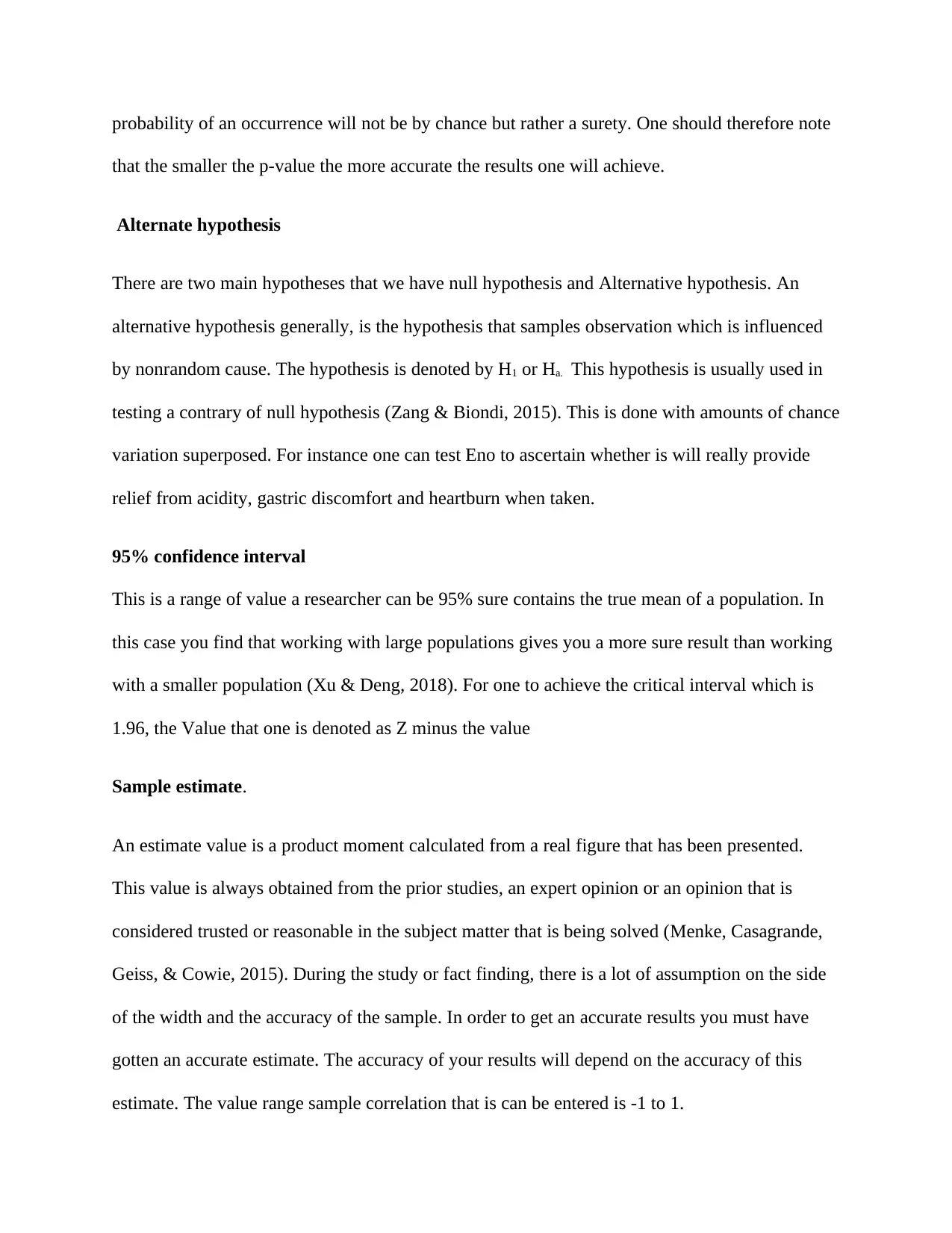
probability of an occurrence will not be by chance but rather a surety. One should therefore note
that the smaller the p-value the more accurate the results one will achieve.
Alternate hypothesis
There are two main hypotheses that we have null hypothesis and Alternative hypothesis. An
alternative hypothesis generally, is the hypothesis that samples observation which is influenced
by nonrandom cause. The hypothesis is denoted by H1 or Ha. This hypothesis is usually used in
testing a contrary of null hypothesis (Zang & Biondi, 2015). This is done with amounts of chance
variation superposed. For instance one can test Eno to ascertain whether is will really provide
relief from acidity, gastric discomfort and heartburn when taken.
95% confidence interval
This is a range of value a researcher can be 95% sure contains the true mean of a population. In
this case you find that working with large populations gives you a more sure result than working
with a smaller population (Xu & Deng, 2018). For one to achieve the critical interval which is
1.96, the Value that one is denoted as Z minus the value
Sample estimate.
An estimate value is a product moment calculated from a real figure that has been presented.
This value is always obtained from the prior studies, an expert opinion or an opinion that is
considered trusted or reasonable in the subject matter that is being solved (Menke, Casagrande,
Geiss, & Cowie, 2015). During the study or fact finding, there is a lot of assumption on the side
of the width and the accuracy of the sample. In order to get an accurate results you must have
gotten an accurate estimate. The accuracy of your results will depend on the accuracy of this
estimate. The value range sample correlation that is can be entered is -1 to 1.
that the smaller the p-value the more accurate the results one will achieve.
Alternate hypothesis
There are two main hypotheses that we have null hypothesis and Alternative hypothesis. An
alternative hypothesis generally, is the hypothesis that samples observation which is influenced
by nonrandom cause. The hypothesis is denoted by H1 or Ha. This hypothesis is usually used in
testing a contrary of null hypothesis (Zang & Biondi, 2015). This is done with amounts of chance
variation superposed. For instance one can test Eno to ascertain whether is will really provide
relief from acidity, gastric discomfort and heartburn when taken.
95% confidence interval
This is a range of value a researcher can be 95% sure contains the true mean of a population. In
this case you find that working with large populations gives you a more sure result than working
with a smaller population (Xu & Deng, 2018). For one to achieve the critical interval which is
1.96, the Value that one is denoted as Z minus the value
Sample estimate.
An estimate value is a product moment calculated from a real figure that has been presented.
This value is always obtained from the prior studies, an expert opinion or an opinion that is
considered trusted or reasonable in the subject matter that is being solved (Menke, Casagrande,
Geiss, & Cowie, 2015). During the study or fact finding, there is a lot of assumption on the side
of the width and the accuracy of the sample. In order to get an accurate results you must have
gotten an accurate estimate. The accuracy of your results will depend on the accuracy of this
estimate. The value range sample correlation that is can be entered is -1 to 1.
Paraphrase This Document
Need a fresh take? Get an instant paraphrase of this document with our AI Paraphraser
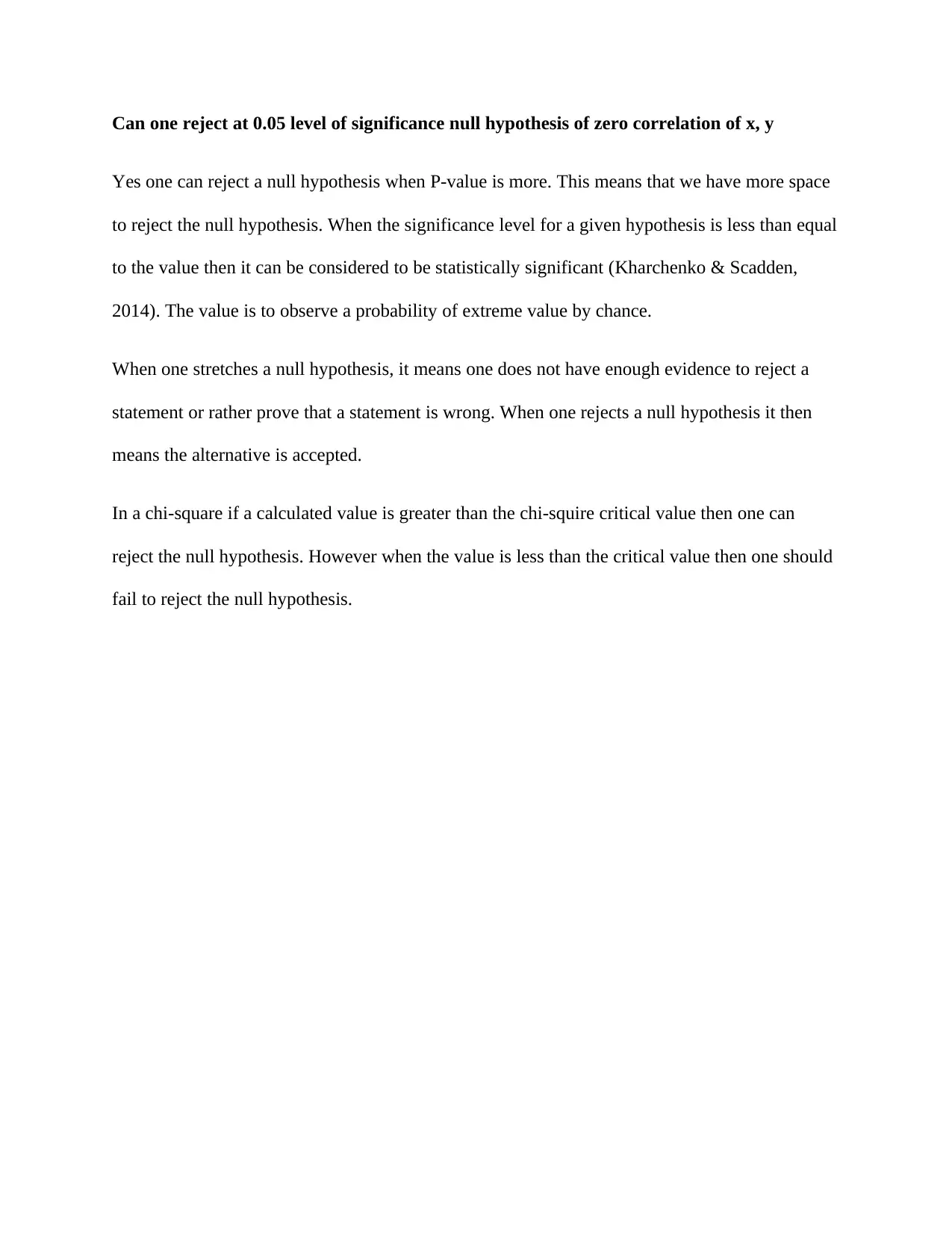
Can one reject at 0.05 level of significance null hypothesis of zero correlation of x, y
Yes one can reject a null hypothesis when P-value is more. This means that we have more space
to reject the null hypothesis. When the significance level for a given hypothesis is less than equal
to the value then it can be considered to be statistically significant (Kharchenko & Scadden,
2014). The value is to observe a probability of extreme value by chance.
When one stretches a null hypothesis, it means one does not have enough evidence to reject a
statement or rather prove that a statement is wrong. When one rejects a null hypothesis it then
means the alternative is accepted.
In a chi-square if a calculated value is greater than the chi-squire critical value then one can
reject the null hypothesis. However when the value is less than the critical value then one should
fail to reject the null hypothesis.
Yes one can reject a null hypothesis when P-value is more. This means that we have more space
to reject the null hypothesis. When the significance level for a given hypothesis is less than equal
to the value then it can be considered to be statistically significant (Kharchenko & Scadden,
2014). The value is to observe a probability of extreme value by chance.
When one stretches a null hypothesis, it means one does not have enough evidence to reject a
statement or rather prove that a statement is wrong. When one rejects a null hypothesis it then
means the alternative is accepted.
In a chi-square if a calculated value is greater than the chi-squire critical value then one can
reject the null hypothesis. However when the value is less than the critical value then one should
fail to reject the null hypothesis.
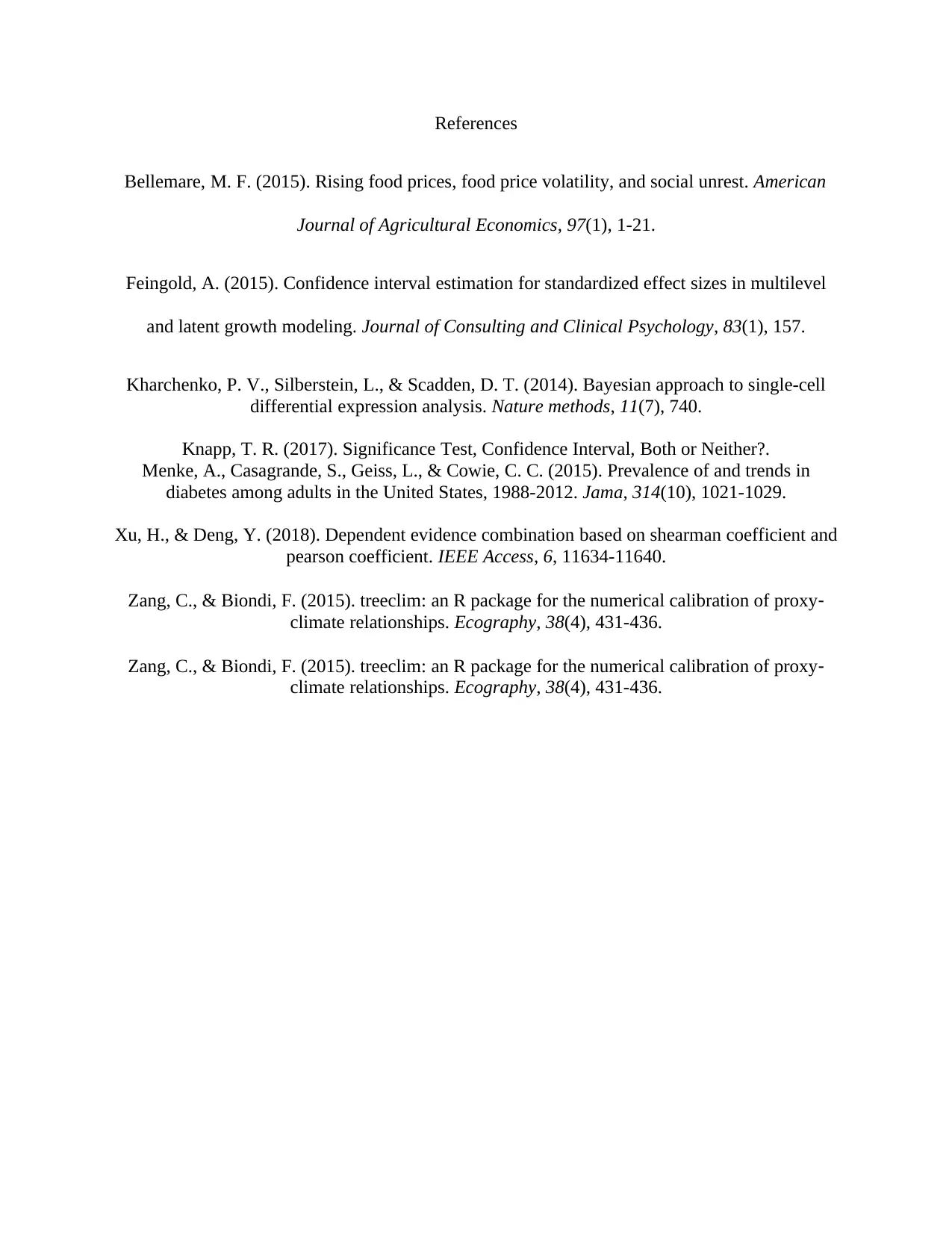
References
Bellemare, M. F. (2015). Rising food prices, food price volatility, and social unrest. American
Journal of Agricultural Economics, 97(1), 1-21.
Feingold, A. (2015). Confidence interval estimation for standardized effect sizes in multilevel
and latent growth modeling. Journal of Consulting and Clinical Psychology, 83(1), 157.
Kharchenko, P. V., Silberstein, L., & Scadden, D. T. (2014). Bayesian approach to single-cell
differential expression analysis. Nature methods, 11(7), 740.
Knapp, T. R. (2017). Significance Test, Confidence Interval, Both or Neither?.
Menke, A., Casagrande, S., Geiss, L., & Cowie, C. C. (2015). Prevalence of and trends in
diabetes among adults in the United States, 1988-2012. Jama, 314(10), 1021-1029.
Xu, H., & Deng, Y. (2018). Dependent evidence combination based on shearman coefficient and
pearson coefficient. IEEE Access, 6, 11634-11640.
Zang, C., & Biondi, F. (2015). treeclim: an R package for the numerical calibration of proxy‐
climate relationships. Ecography, 38(4), 431-436.
Zang, C., & Biondi, F. (2015). treeclim: an R package for the numerical calibration of proxy‐
climate relationships. Ecography, 38(4), 431-436.
Bellemare, M. F. (2015). Rising food prices, food price volatility, and social unrest. American
Journal of Agricultural Economics, 97(1), 1-21.
Feingold, A. (2015). Confidence interval estimation for standardized effect sizes in multilevel
and latent growth modeling. Journal of Consulting and Clinical Psychology, 83(1), 157.
Kharchenko, P. V., Silberstein, L., & Scadden, D. T. (2014). Bayesian approach to single-cell
differential expression analysis. Nature methods, 11(7), 740.
Knapp, T. R. (2017). Significance Test, Confidence Interval, Both or Neither?.
Menke, A., Casagrande, S., Geiss, L., & Cowie, C. C. (2015). Prevalence of and trends in
diabetes among adults in the United States, 1988-2012. Jama, 314(10), 1021-1029.
Xu, H., & Deng, Y. (2018). Dependent evidence combination based on shearman coefficient and
pearson coefficient. IEEE Access, 6, 11634-11640.
Zang, C., & Biondi, F. (2015). treeclim: an R package for the numerical calibration of proxy‐
climate relationships. Ecography, 38(4), 431-436.
Zang, C., & Biondi, F. (2015). treeclim: an R package for the numerical calibration of proxy‐
climate relationships. Ecography, 38(4), 431-436.
⊘ This is a preview!⊘
Do you want full access?
Subscribe today to unlock all pages.

Trusted by 1+ million students worldwide
1 out of 6
Related Documents
Your All-in-One AI-Powered Toolkit for Academic Success.
+13062052269
info@desklib.com
Available 24*7 on WhatsApp / Email
![[object Object]](/_next/static/media/star-bottom.7253800d.svg)
Unlock your academic potential
Copyright © 2020–2025 A2Z Services. All Rights Reserved. Developed and managed by ZUCOL.





